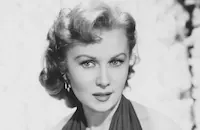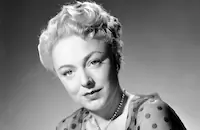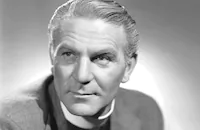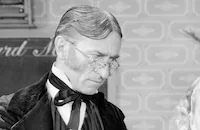The previous year had seen the release of Road to Utopia - the latest in the Crosby/Bob Hope/Dorothy Lamour laugh fests - and proceeded to live up to its title becoming 1945's top grossing picture. Added to his soaring record sales and highly rated Philco radio series, Bing ruled the post-war years, pre-eminently at Paramount where his current contract granted him director/cast/writer approval. His busy schedule permitting, the shrewd star made sure to throw in an occasional Technicolor special, and Crosby's choice of directors for these prime projects seemed (at least on the surface) a bit odd. Blue Skies had been helmed by Stuart Heisler, a former editor-turned-director, whose forte for action pictures and noirish dramas began with 1942's The Glass Key. The Emperor Waltz (1948) was a Billy Wilder extravaganza, who, while renowned as the co-writer of such confections as Ninotchka (1939) and Ball of Fire (1941), had, during this period, only directed one comedy (The Major and the Minor, 1942); his last two movies had been Double Indemnity (1944) and The Lost Weekend (1945). Now with the Technicolor cameras set to roll on a tailor-made remake of Mark Twain's A Connecticut Yankee in King Arthur's Court (previously filmed in 1921 and again ten years later as an acclaimed Will Rogers talkie), Crosby turned once again to filmdom's darkest corners - selecting Tay Garnett, best known for his classic adaptation of James M. Cain's The Postman Always Rings Twice (1946).
Like Billy Wilder, Garnett, while synonymous with tough, gritty pictures (Bataan, 1943), had a formidable background in comedy, having entered the industry in 1920 as a gag writer for Mack Sennett and Hal Roach. The wily Bing knew the post WWII viewers needed their laughs tempered with sarcasm and irony, and these "unlikely" directors more than fit the bill.
Paramount, who would pull out all the proverbial stops for the upcoming production, began with the cast: certainly the role of the easy-going Hank, a New England mechanic mysteriously transported back to the days of Camelot, fit Crosby like a glove, and with such stellar support as William Bendix, Murvyn Vye, Henry Wilcoxon and Alan Napier, the right cogs indeed seemed to be in place. Bing's female co-star would be the gorgeous flame-haired Rhonda Fleming, still new to the motion picture scene but already on her way to challenging Maureen O'Hara for the title of Queen of Technicolor. Her appearance in A Connecticut Yankee in King Arthur's Court would not let her growing fans down: sumptuously adorned in Edith Head creations, she was, in a word, ravishing. Finally, as an aging, runny-nosed King Arthur, Cedric Hardwicke walked away with most of the best reviews, giving a thoroughly delightful comic performance.
The funny anachronistic script was penned by Edmund Beloin, an A-list Forties scribe, who had provided Paramount with a slew of hilarious cinematic bulls eyes including Road to Rio, Bob Hope's sidesplitting My Favorite Brunette (both 1947), as well as two Jack Benny classics, Buck Benny Rides Again and Love Thy Neighbor (both 1940). As for the music score for A Connecticut Yankee in King Arthur's Court, it was composed by Victor Young and featured some classy Johnny Burke and Jimmy Van Heusen compositions. However, a major contribution to the picture's enormous favor with critics and audiences alike was the spectacular Technicolor camerawork, courtesy of the brilliant Ray Rennahan, who by 1949 was the industry-acknowledged master of the process having worked on two-strip test films in the early 1920s. Rennahan's stunning work for the Technicolor company resulted in such landmark productions as Whoopee! (1930), Doctor X (1932), Mystery of the Wax Museum (1933), Kid Millions (1934 - the first live action three-strip sequence), Becky Sharp (1935 - the first full-length three-strip feature), and Wings of the Morning (1937 - the first British Technicolor feature). Not surprisingly, A Connecticut Yankee in King Arthur's Court was one of 1949's movie highlights, putting yet another feather in Paramount's Crosby cap, in addition to remaining the best filmed version to date of Twain's beloved story.
Producer: Robert M. Fellows
Director: Tay Garnett
Screenplay: Edmund Beloin, based on the novel by Mark Twain
Art Direction: Roland Anderson, Hans Dreier
Cinematography: Ray Rennahan
Costume Design: Mary Kay Dodson, Edith Head, Gile Steele
Film Editing: Archie Marshek
Original Music: Victor Young, Johnny Burke, Jimmy Van Heusen
Cast: Bing Crosby (Hank Martin), Rhonda Fleming (Alisande La Carteloise), Cedric Hardwicke (King Arthur), William Bendix (Sir Sagramore), Murvyn Vye (Merlin), Henry Wilcoxon (Sir Lancelot), Virginia Field (Morgan Le Fay), Joseph Vitale (Sir Logris).
C-107m.
by Mel Neuhaus































